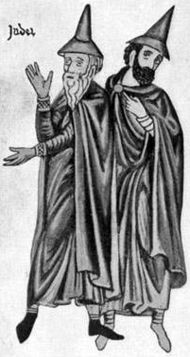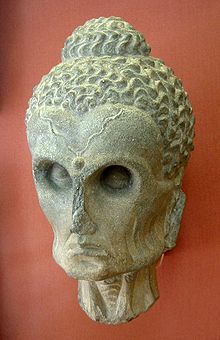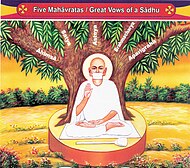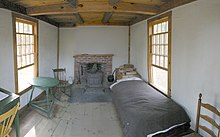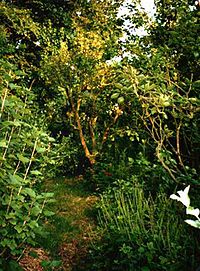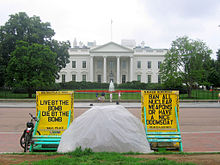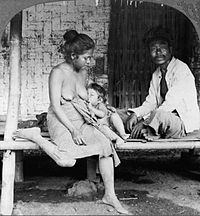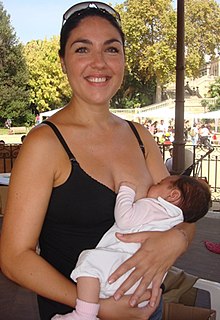Pursuing enlightenment, Buddha first practiced severe asceticism before recommending a non-ascetic middle way. In Christianity, Francis of Assisi and his followers practiced extreme acts of asceticism.
Asceticism (/əˈsɛtɪsɪzəm/; from the Greek: ἄσκησις áskesis, "exercise, training") is a lifestyle characterized by abstinence from sensual pleasures, often for the purpose of pursuing spiritual goals. Ascetics may withdraw from the world for their practices or continue to be part of their society, but typically adopt a frugal lifestyle, characterised by the renunciation of material possessions and physical pleasures, and time spent fasting while concentrating on the practice of religion or reflection upon spiritual matters.
Asceticism has been historically observed in many religious traditions, including Buddhism, Jainism, Hinduism, Christianity, and Judaism. Contemporary mainstream Islam practices asceticism in the form of fasting during Ramadan by abstaining from all sensual pleasures, food & water from sunrise until sunset. The observation of fasting during Ramadan is purely done for God and to increase one's spiritual connection with God; it is compulsory on all Muslims to fast as it is one of the Five Pillars of Islam. The Sufism sects tradition has included strict asceticism throughout history. The practitioners of these religions abandoned sensual pleasures and led an abstinent lifestyle, in the pursuit of redemption, salvation or spirituality. Asceticism is seen in the ancient theologies as a journey towards spiritual transformation, where the simple is sufficient, the bliss is within, the frugal is plenty. Inversely, several ancient religious traditions, such as Zoroastrianism, Ancient Egyptian Religion and the Dionysian Mysteries, as well as more modern Left Hand traditions, openly reject ascetic practises and focus on various types of hedonism.
Etymology and meaning
Dom Cuthbert Butler classified asceticism into natural and unnatural forms:
- "Natural asceticism" involves a lifestyle which reduces material aspects of life to the utmost simplicity and to a minimum. This may include minimal, simple clothing, sleeping on a floor or in caves, and eating a simple minimal amount of food. Natural asceticism, state Wimbush and Valantasis, does not include maiming the body or harsher austerities that make the body suffer.
- "Unnatural asceticism", in contrast, covers practices that go further, and involves body mortification, punishing one's own flesh, and habitual self-infliction of pain - such as by sleeping on a bed of nails.
Religions
Self-discipline and abstinence in some form and degree are parts of religious practice within many religious and spiritual traditions. Ascetic lifestyle is associated particularly with monks, nuns, fakirs in Abrahamic religions, and bhikkhus, munis, sannyasis, yogis in Indian religions.Abrahamic religions
Christianity
Christian authors of late antiquity such as Origen, St. Jerome, St. Ignatius, John Chrysostom, and Augustine interpreted meanings of Biblical texts within a highly asceticized religious environment. Scriptural examples of asceticism could be found in the lives of John the Baptist, Jesus, the twelve apostles and the Apostle Paul. The Dead Sea Scrolls revealed ascetic practices of the ancient Jewish sect of Essenes who took vows of abstinence to prepare for a holy war. An emphasis on an ascetic religious life was evident in both early Christian writings (see the Philokalia) and practices (see hesychasm). Other Christian practitioners of asceticism include individuals such as Simeon Stylites, Saint David of Wales and Francis of Assisi.According to Richard Finn, much of early Christian asceticism has been traced to Judaism, but not to traditions within Greek asceticism. Some of the ascetic thoughts in Christianity nevertheless, Finn states, have roots in Greek moral thought. Virtuous living is not possible when an individual is craving bodily pleasures with desire and passion. Morality is not seen in the ancient theology as a balancing act between right and wrong, but a form of spiritual transformation, where the simple is sufficient, the bliss is within, the frugal is plenty.
The deserts of the Middle East were at one time inhabited by thousands of Christian hermits including St. Anthony the Great (aka St. Anthony of the Desert), St. Mary of Egypt, and St. Simeon Stylites. In 963 CE, an association of monasteries called Lavra was formed on Mount Athos, in Eastern Orthodox tradition. This became the most important center of orthodox Christian ascetic groups in the centuries that followed. In the modern era, Mount Athos and Meteora have remained a significant center.
Sexual abstinence such as those of the Encratites sect of Christians was only one aspect of ascetic renunciation, and both natural and unnatural asceticism have been part of Christian asceticism. The natural ascetic practices have included simple living, begging, fasting and ethical practices such as humility, compassion, patience and prayer. Evidence of extreme unnatural asceticism in Christianity appear in 2nd century texts and thereafter, in both the Eastern Orthodox Christianity and the Western sister tradition, such as the practice of chaining the body to rocks, eating only grass, praying seated on a pillar in the elements for decades such as by the monk Simeon Stylites, solitary confinement inside a cell, abandoning personal hygiene and adopting lifestyle of a beast, self-inflicted pain and voluntary suffering. Such ascetic practices were linked to the Christian concepts of sin and redemption.
Evagrius Ponticus: monastic teaching
Evagrius Ponticus, also called Evagrius the Solitary (345-399 AD) was a highly educated monastic teacher who produced a large theological body of work, mainly ascetic, including the Gnostikos (from Ancient Greek: γνωστικός gnostikos, "learned", from γνῶσις gnōsis, knowledge), also known as The Gnostic: To the One Made Worthy of Gnosis. The Gnostikos is the second volume of a trilogy containing the Praktikos, intended for young monks to achieve apatheia, i.e. " a state of calm which is the prerequisite for love and knowledge ", in order to purify their intellect and make it impassible to reveal the truth hidden in every being. The third book, Kephalaia Gnostika, was meant for meditation by advanced monks. Those writings made him one of the most recognized ascetic teachers and scriptural interpreters of his time, which include Clement of Alexandria and Origen.The ascetic literature of early Christianity was influenced by pre-Christian Greek philosophical traditions, especially Plato and Aristotle, looking for the perfect spiritual way of life. According to Clement of Alexandria, Philosophy and Scriptures can be seen as "double expressions of one pattern of knowledge ". According to Evagrius, " body and the soul are there to help the intellect and not to hinder it ".
Islam
The Arabic word for asceticism is zuhd (Zuhd in Islam). The prophet Mohammad and his followers practiced asceticism. However, contemporary mainstream Islam has not had a tradition of asceticism, but its Sufi sects – a minority within Islam – have cherished an ascetic tradition for many centuries. Monasticism is forbidden in Islam.Sufism
A Sufi Muslim ascetic (fakir) in Bengal in the 1860s.
Scholars in the field of Sufi studies have argued that asceticism (zuhd) served as a precursor to the later doctrinal formations of Sufis that began to emerge in the 10th century through the works of individuals such as al-Junayd, al-Qushayrī, al-Sarrāj, al-Hujwīrī, and others.
Sufism grew as a mystical, somewhat hidden tradition in the mainstream Sunni and Shia Islam, state Eric Hanson and Karen Armstrong, likely in reaction to "the growing worldliness of Ummayyad and 'Abassid societies". Acceptance of asceticism emerged in Sufism slowly because it was contrary to the sunnah, states Nile Green, and early Sufis condemned "ascetic practices as unnecessary public displays of what amounted to false piety". The ascetic Sufis were hunted and persecuted by Sunni and Shia rulers, in various centuries.
Sufism was adopted and then grew particularly in the frontier areas of Islamic states, where the asceticism of its fakirs (or dervish) appealed to a population used to the monastic traditions of Buddhism, Hinduism or Christianity. Ascetic practices of Sufi fakirs have included celibacy, fasting and self-mortification. Sufi ascetics also participated in mobilizing Islamic warriors for holy war, helping travelers, dispensing blessings through their perceived magical powers, and in helping settle disputes.
Ritual ascetic practices, such as self-flagellation (Tatbir) has been practiced by Shia Muslims annually at the Mourning of Muharram.
Judaism
Chassidei Ashkenaz were a Jewish mystical and ascetic movement in medieval Germany.
Asceticism has not been a dominant theme within Judaism, but minor to significant ascetic traditions have been a part of Jewish spirituality. The history of Jewish asceticism is traceable to 1st millennium BCE era with the references of the Nazirite (or Nazorean, Nazarene, Naziruta, Nazir), whose rules of practice are found in Book of Numbers 6:1-21. The ascetic practices included not cutting the hair, abstaining from eating meat or grapes, abstention from wine, or fasting and hermit style living conditions for a period of time. Literary evidence suggests that this tradition continued for a long time, well into the common era, and both Jewish men and women could follow the ascetic path, with examples such as the ascetic practices for fourteen years by Queen Helena of Adiabene, and by Miriam of Tadmor. After the Jews returned from the Babylonian exile and the Mosaic institution was done away with, a different form of asceticism arose when Antiochus IV Epiphanes threatened the Jewish religion in 167 BC. The Hasidaean-Essene tradition of the second Temple period is described as one of the movements within historic Jewish asceticism between 2nd century BCE and 1st century CE.
Ascetic Jewish sects existed in ancient and medieval era times, most notably the Essenes and Ebionites. According to Allan Nadler, two most significant examples of medieval Jewish asceticism have been Havoth ha-Levavoth and Hasidei Ashkenaz. Pious self-deprivation was a part of the dualism and mysticism in these ascetic groups. This voluntary separation from the world was called Perishuth, and the Jewish society widely accepted this tradition in late medieval era. Extreme forms of ascetic practices have been opposed or controversial in the Hassidic movement.
The Ashkenazi Hasidim (Hebrew: חסידי אשכנז, Chassidei Ashkenaz) were a Jewish mystical, ascetic movement in the German Rhineland whose practices are documented in the texts of the 12th and 13th centuries. Peter Meister states that this Jewish asceticism emerged in the 10th century, grew much wider with prevalence in southern Europe and the Middle East through the Jewish pietistic movement. According to Shimon Shokek, these ascetic practices were the result of an influence of medieval Christianity on Ashkenazi Hasidism. The Jewish faithful of this Hasidic tradition practiced the punishment of body, self-torture by starvation, sitting in the open in freezing snow, or in the sun with fleas in summer, all with the goal of purifying the soul and turning one's attention away from the body unto the soul.
Another significant school of Jewish asceticism appeared in the 16th-century led from Safed. These mystics engaged in radical material abstentions and self-mortification with the belief that this helps them transcend the created material world, reach and exist in the mystical spiritual world. A studied example of this group was Hayyim ben Joseph Vital, and their rules of ascetic lifestyle (Hanhagoth) are documented.
Bahá'í Faith
According to Shoghi Effendi, in Bahai faith, the maintenance of a high standard of moral conduct is not to be associated or confused with any form of asceticism, or of excessive and bigoted puritanism. The standard inculcated by Bahá’u’lláh seeks, under no circumstances, to deny anyone the legitimate right and privilege to derive the fullest advantage and benefit from the manifold joys, beauties, and pleasures with which the world has been so plentifully enriched by an All-Loving Creator.Indian religions
Asceticism is found in both non-theistic and theistic traditions within Indian religions. The origins of the practice are ancient and a heritage shared by major Indian religions such as Buddhism, Hinduism and Jainism. These probably developed from a syncretism of Vedic and Sramanic influences.Asceticism in Indian religions includes a spectrum of diverse practices, ranging from the mild self-discipline, self-imposed poverty and simple living typical of Buddhism and Hinduism, to more severe austerities and self-mortification practices of monks in Jainism and now extinct Ajivikas in the pursuit of salvation. Some ascetics live as loner hermits relying on whatever food they can find in the forests, then sleep and meditate in caves; others travel from one holy site to another while sustaining their body by begging for food; yet others live in monasteries as monks or nuns. Some ascetics live like priests and preachers, other ascetics are armed and militant, to resist any persecution – a phenomenon that emerged after the arrival of Islam in India. Self-torture is relatively uncommon practice but one that attracts public attention. In Indian traditions such as Buddhism and Hinduism, self-mortification is typically criticized. However, Indian mythologies also describe numerous ascetic gods or demons who pursued harsh austerities for decades or centuries that helped each gain special powers.
Buddhism
The Buddha as an ascetic. Gandhara, 2-3rd century CE. British Museum.
The historical Siddhartha Gautama adopted an extreme ascetic life in search of enlightenment. However, before enlightenment he rejected extreme asceticism.
According to Hajime Nakamura and other scholars, some early Buddhist texts suggest that asceticism was a part of Buddhist practice in its early days. Further, in practice, records from about the start of the common era through the 19th century CE suggest that asceticism has been a part of Buddhism, both in Theravada and Mahayana traditions.
Theravada
Textual evidence suggests that ascetic practices were a part of the Buddhist tradition in Sri Lanka by the 3rd century BCE, and this tradition continued through the medieval era in parallel to sangha style monastic tradition.In the Theravada tradition of Thailand, medieval texts report of ascetic monks who wander and dwell in the forest or crematory alone, do austere practices, and these came to be known as Thudong. Ascetic Buddhist monks have been and continue to be found in Myanmar, and as in Thailand, they are known to pursue their own version of Buddhism, resisting the hierarchical institutionalized sangha structure of monasteries in Buddhism.
Mahayana
In the Mahayana tradition, asceticism with esoteric and mystical meanings became an accepted practice, such as in the Tendai and Shingon schools of Japanese Buddhism. These Japanese practices included penance, austerities, ablutions under a waterfall, and rituals to purify oneself. Japanese records from the 12th century record stories of monks undertaking severe asceticism, while records suggest that 19th century Nichiren Buddhist monks woke up at midnight or 2:00 AM daily, and performed ascetic water purification rituals under cold waterfalls. Other practices include the extreme ascetic practices of eating only pine needles, resins, seeds and ultimately self-mummification, while alive, or Sokushinbutsu (miira) in Japan.In Chinese Buddhism, self-mummification ascetic practices were less common but recorded in the Ch'an (Zen Buddhism) tradition there. More ancient Chinese Buddhist asceticism, somewhat similar to Sokushinbutsu are also known, such as the public self-immolation (self cremation, as shaoshen 燒身 or zifen 自焚) practice, aimed at abandoning the impermanent body. The earliest documented ascetic Buddhist monk biography is of Fayu (法羽) in 396 CE, followed by more than fifty documented cases in the centuries that followed including that of monk Daodu (道度). This was considered as evidence of a renunciant bodhisattva, and may have been inspired by the Jataka tales wherein the Buddha in his earlier lives immolates himself to assist other living beings, or by the Bhaiṣajyaguruvaiḍūryaprabhārāja-related teachings in the Lotus Sutra. Historical records suggest that the self-immolation practices were observed by nuns in Chinese Buddhism as well.
The Chinese Buddhist asceticism practices, states James Benn, were not an adaptation or import of Indian ascetic practices, but an invention of Chinese Buddhists, based on their unique interpretations of Saddharmapuṇḍarīka or Lotus Sūtra. It may be an adoption of more ancient pre-Buddhist Chinese practices, or from Taoism. It is unclear if self-immolation was limited primarily to Chinese asceticism tradition, and strong evidence of it being a part of a large scale, comprehensive ascetic program among Chinese Buddhists is lacking.
Hinduism
A female ascetic of the Vaishnavism tradition, 19th-century India.
Renunciation from the worldly life, and a pursuit of spiritual life either as a part of monastic community or as a loner, has been a historic tradition of Hinduism since ancient times. The renunciation tradition is called Sannyasa, and this is not the same as asceticism – which typically connotes severe self-denial and self-mortification. Sannyasa often involved a simple life, one with minimal or no material possessions, study, meditation and ethical living. Those who undertook this lifestyle were called Sannyasi, Sadhu, Yati, Bhiksu, Pravrajita/Pravrajitā, and Parivrajaka in Hindu texts. The term with a meaning closer to asceticism in Hindu texts is Tapas, but it too spans a spectrum of meanings ranging from inner heat, to self-mortification and penance with austerities, to meditation and self-discipline.
Female Asceticism
—Lynn Denton, Female Ascetics in Hinduism
Indeed, Vedic literature does provide irrefutable
evidence for the existence of both female celibate
students and female renouncers in ancient India.
evidence for the existence of both female celibate
students and female renouncers in ancient India.
Asceticism-like practices are hinted in the Vedas, but these hymns have been variously interpreted as referring to early Yogis and loner renouncers. One such mention is in the Kesin hymn of the Rigveda, where Keśins ("long-haired" ascetics) and Munis ("silent ones") are described. These Kesins of the Vedic era, are described as follows by Karel Werner:
The Keśin does not live a normal life of convention. His hair and beard grow longer, he spends long periods of time in absorption, musing and meditating and therefore he is called "sage" (muni). They wear clothes made of yellow rags fluttering in the wind, or perhaps more likely, they go naked, clad only in the yellow dust of the Indian soil. But their personalities are not bound to earth, for they follow the path of the mysterious wind when the gods enter them. He is someone lost in thoughts: he is miles away.The Vedic and Upanishadic texts of Hinduism, states Mariasusai Dhavamony, do not discuss self-inflicted pain, but do discuss self-restraint and self-control. The monastic tradition of Hinduism is evidenced in 1st millennium BCE, particularly in its Advaita Vedanta tradition. This is evidenced by the oldest Sannyasa Upanishads, because all of them have a strong Advaita Vedanta outlook. Most of the Sannyasa Upanishads present a Yoga and nondualism (Advaita) Vedanta philosophy. The 12th-century Shatyayaniya Upanishad is a significant exception, which presents qualified dualistic and Vaishnavism (Vishishtadvaita Vedanta) philosophy. These texts mention a simple, ethical lifestyle but do not mention self-torture or body mortification. For example,
— Karel Werner (1977), "Yoga and the Ṛg Veda: An Interpretation of the Keśin Hymn"
These are the vows a Sannyasi must keep –Similarly, the Nirvana Upanishad asserts that the Hindu ascetic should hold, according to Patrick Olivelle, that "the sky is his belief, his knowledge is of the absolute, union is his initiation, compassion alone is his pastime, bliss is his garland, the cave of solitude is his fellowship", and so on, as he proceeds in his effort to gain self-knowledge (or soul-knowledge) and its identity with the Hindu metaphysical concept of Brahman. Other behavioral characteristics of the Sannyasi include: ahimsa (non-violence), akrodha (not become angry even if you are abused by others), disarmament (no weapons), chastity, bachelorhood (no marriage), avyati (non-desirous), amati (poverty), self-restraint, truthfulness, sarvabhutahita (kindness to all creatures), asteya (non-stealing), aparigraha (non-acceptance of gifts, non-possessiveness) and shaucha (purity of body speech and mind).
Abstention from injuring living beings, truthfulness, abstention from appropriating the property of others, abstention from sex, liberality (kindness, gentleness) are the major vows. There are five minor vows: abstention from anger, obedience towards the guru, avoidance of rashness, cleanliness, and purity in eating. He should beg (for food) without annoying others, any food he gets he must compassionately share a portion with other living beings, sprinkling the remainder with water he should eat it as if it were a medicine.
— Baudhayana Dharmasūtra, II.10.18.1-10
The 11th century text, Yatidharmasamuccaya is a Vaishnavism text that summarizes ascetic practices in Vaishnavism tradition of Hinduism. In Hindu traditions, as with other Indian religions, both men and women have historically participated in a diverse spectrum of ascetic practices.
Jainism
Asceticism in one of its most intense forms can be found in one of the oldest religions, known as Jainism. Ascetic life may include nakedness symbolizing non-possession of even clothes, fasting, body mortification, penance and other austerities, in order to burn away past karma and stop producing new karma, both of which are believed in Jainism to be essential for reaching siddha and moksha (liberation from rebirths, salvation). In Jainism, the ultimate goal of life is to achieve the liberation of soul from endless cycle of rebirths (moksha from samsara), which requires ethical living and asceticism. Most of the austerities and ascetic practices can be traced back to Vardhaman Mahavira, the twenty-fourth "fordmaker" or Tirthankara who practiced 12 years of asceticism before reaching enlightenment.Jain texts such as Tattvartha Sutra and Uttaradhyayana Sutra discuss ascetic austerities to great lengths and formulations. Six outer and six inner practices are most common, and oft repeated in later Jain texts. According to John Cort, outer austerities include complete fasting, eating limited amounts, eating restricted items, abstaining from tasty foods, mortifying the flesh and guarding the flesh (avoiding anything that is a source of temptation). Inner austerities include expiation, confession, respecting and assisting mendicants, studying, meditation and ignoring bodily wants in order to abandon the body.
The Jain text of Kalpasutra describes Mahavira's asceticism in detail, whose life is a source of guidance on most of the ascetic practices in Jainism:
The Venerable Ascetic Mahavira for a year and a month wore clothes; after that time he walked about naked, and accepted the alms in the hollow of his hand. For more than twelve years the Venerable Ascetic Mahivira neglected his body and abandoned the care of it; he with equanimity bore, underwent, and suffered all pleasant or unpleasant occurrences arising from divine powers, men, or animals.Both Mahavira and his ancient Jaina followers are described in Jainism texts as practicing body mortification and being abused by animals as well as people, but never retaliating and never initiating harm or injury (ahimsa) to any other being. With such ascetic practices, he burnt off his past Karma, gained spiritual knowledge, and became a Jina. These austere practices are part of the monastic path in Jainism. The practice of body mortification is called kaya klesha in Jainism, and is found in verse 9.19 of the Tattvartha Sutra by Umaswati, the most authoritative oldest surviving Jaina philosophical text.
— Kalpa Sutra 117
Monastic practice
Five Mahavratas of Jain ascetics
In Jain monastic practice, the monks and nuns take ascetic vows, after renouncing all relations and possessions. The vows include a complete commitment to nonviolence (Ahimsa). They travel from city to city, often crossing forests and deserts, and always barefoot. Jain ascetics do not stay in a single place for more than two months to prevent attachment to any place. However, during the four months of monsoon (rainy season) known as chaturmaas, they stay at a single place to avoid killing life forms that thrive during the rains. Jain monks and nuns practice complete celibacy. They do not touch or share a sitting platform with a person of the opposite sex.
Jain ascetics follow a strict vegetarian diet without root vegetables. Prof. Pushpendra K. Jain explains:
Clearly enough, to procure such vegetables and fruits, one must pull out the plant from the root, thus destroying the entire plant, and with it all the other micro organisms around the root. Fresh fruits and vegetables should be plucked only when ripe and ready to fall off, or ideally after they have fallen off the plant. In case they are plucked from the plants, only as much as required should be procured and consumed without waste.The monks of Shvetambara sub-tradition within Jainism do not cook food, but solicit alms from householders. Digambara monks have only a single meal a day. Neither group will beg for food, but a Jain ascetic may accept a meal from a householder, provided that the latter is pure of mind and body, and offers the food of his own volition and in the prescribed manner. During such an encounter, the monk remains standing and eats only a measured amount. Fasting (i.e., abstinence from food and sometimes water) is a routine feature of Jain asceticism. Fasts last for a day or longer, up to a month. Some monks avoid (or limit) medicine and/or hospitalization out of disregard for the physical body.
Shvetambara monks and nuns wear only unstitched white robes (an upper and lower garment), and own one bowl they use for eating and collecting alms. Male Digambara sect monks do not wear any clothes, carry nothing with them except a soft broom made of shed peacock feathers (pinchi) to gently remove any insect or living creature in their way or bowl, and they eat with their hands. They sleep on the floor without blankets, and sit on wooden platforms. Other austerities include meditation in seated or standing posture near river banks in the cold wind, or meditation atop hills and mountains, especially at noon when the sun is at its fiercest. Such austerities are undertaken according to the physical and mental limits of the individual ascetic.
When death is imminent from an advanced age or terminal disease, many Jain ascetics take a final vow of Santhara or Sallekhana, a fast to peaceful and detached death, by first reducing intake of and then ultimately abandoning all medicines, food, and water. Scholars state that this ascetic practice is not a suicide, but a form of natural death, done without passion or turmoil or suddenness, and because it is done without active violence to the body.
Other religions
Inca religion
In Inca religion of medieval South America, asceticism was practiced. The high priests of the Inca people lived an ascetic life, which included fasting, chastity and eating simple food. The Jesuit records report Christian missionaries encountering ascetic Inca hermits in the Andean mountains.Taoism
Historical evidence suggest that the monastic tradition in Taoism practiced asceticism, and the most common ascetic practices included fasting, complete sexual abstinence, self-imposed poverty, sleep deprivation, and secluding oneself in the wilderness. More extreme and unnatural ascetic Taoist practices have included public self-drowning and self-cremation. The goal of these spectrum of practices, like other religions, was to reach the divine and get past the immortal body. According to Stephen Eskildsen, asceticism continues to be a part of modern Taoism.Zoroastrianism
In Zoroastrianism, active participation in life through good thoughts, good words and good deeds is necessary to ensure happiness and to keep the chaos at bay. This active participation is a central element in Zoroaster's concept of free will. In the Avesta, the sacred scriptures of Zoroastrianism, fasting and mortification are forbidden.Sociological and psychological views
Early 20th-century German sociologist Max Weber made a distinction between innerweltliche and ausserweltliche asceticism, which means (roughly) "inside the world" and "outside the world", respectively. Talcott Parsons translated these as "worldly" and "otherworldly"—however, some translators use "inner-worldly", and this is more in line with inner world explorations of mysticism, a common purpose of asceticism. "Inner- or Other-worldly" asceticism is practised by people who withdraw from the world to live an ascetic life (this includes monks who live communally in monasteries, as well as hermits who live alone). "Worldly" asceticism refers to people who live ascetic lives but do not withdraw from the world.Wealth is thus bad ethically only in so far as it is a temptation to idleness and sinful enjoyment of life, and its acquisition is bad only when it is with the purpose of later living merrily and without care.Weber claimed this distinction originated in the Protestant Reformation, but later became secularized, so the concept can be applied to both religious and secular ascetics.
— Max Weber, The Protestant Ethic and the Spirit of Capitalism
The 20th-century American psychological theorist David McClelland suggested worldly asceticism is specifically targeting worldly pleasures that "distract" people from their calling and may accept worldly pleasures that are not distracting. As an example, he pointed out Quakers have historically objected to bright-coloured clothing, but wealthy Quakers often made their drab clothing out of expensive materials. The color was considered distracting, but the materials were not. Amish groups use similar criteria to make decisions about which modern technologies to use and which to avoid.



